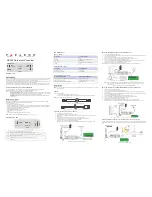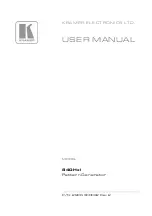
IQUDC30/IQUDC31/IQUDC32/IQUDC33
Operation Using the RollCall Control Panel
Issue 1 Rev 4
Page 79
© 2016 SAM
5.12.1.2
Source (SD)
For SD video standards, the supported input timecode formats are VITC and ATC. As with
HD, ATC can mean that timecode data formatted as LTC, VITC, or both will be detected at the
input; however, only one format can be selected.
•
VITC:
Select VITC only if detected when video input is SD.
•
ATC LTC:
Select ATC LTC only if detected when video input is SD.
•
ATC VTIC:
Select ATC VITC only if detected when video input is SD.
If the selected format is not detected at the input, no timecode processing will be available.
5.12.1.3
Status
The Status box reports which type of embedded timecode is detected within the video input to
this processing channel. If no valid timecode is detected, “None” is displayed.
5.12.2 Processing
The processing controls enable you to select a mode of operation for timecode processing.
5.12.2.1
Mode
Two modes are available for timecode processing.
•
Follow Input:
The input timecode is read every frame and the actual time elapsed
since timecode 00:00:00:00 is calculated. This elapsed time is then converted into an
output timecode that matches the output video frame, and inserted into the output.
There is an additional and complicated process to compensate for clock offset
between in and out, which will generate repeated or skipped timecodes as necessary,
just as happens when synchronizing at the same standard. If the output is
clock-locked to the input, this process has no effect.
•
Generate:
The unit generates the output timecode internally to match the output
video standard. You can specify a start time in the Timecode Entry box. See see
section 5.12.2.3 below.
5.12.2.2
On Timecode Loss
On Timecode Loss defines how the embedded output timecode should behave if input
timecode cannot be detected.
•
Freeze:
On timecode loss, the output timecode will freeze at the last valid detected
input value, until the valid input returns.
•
Free Run:
On timecode loss, the output timecode will switch to free-run and generate
its own timecode starting from the last valid detected input value, until the valid input
returns.
Note:
In Follow Input mode, only the selected source type of ANC packet is inserted into the
output video. Therefore, the action on timecode loss is only applicable to the selected
ATC type.
















































